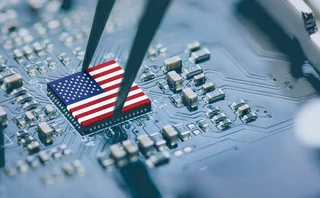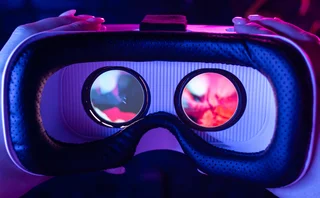The New Guard: Ryusuke Yokoyama, JPX
Ryusuke Yokoyama sits down with Wei-Shen Wong to discuss his three-decade career at the TSE and JPX, how the exchange is looking to help the industry improve its settlement cycles and how the company is experimenting with blockchain and AI technologies. Photos by Richard Atrero de Guzman

On the 14th floor of Japan Exchange Group’s (JPX’s) headquarters, situated in Japan’s largest financial district, Kabuto-cho, Ryusuke Yokoyama, dressed in a dark blue-grey suit paired with a royal purple tie, walks into the meeting room with a smile. He speaks English, but prefers to conduct this interview in Japanese. Seiko Takagi from JPX’s IT development department, as well as Mio Nishino and Shinichi Yaguchi from JPX’s communications department, are on hand to translate.
Yokoyama is the chief information officer (CIO) of Japan Exchange Group (JPX), which came into existence in 2013 after the Tokyo Stock Exchange (TSE) merged with the Osaka Exchange (OSE). He is a TSE lifer, having joined the company in 1986 straight out of university.
It is not every day you meet a C-level executive who has spent his or her entire career at one company. This may seem like a rarity in most places, but not in Japan, where, until fairly recently, this was considered normal.
Back when he first joined TSE, the exchange’s mindset and approach to IT was very different than it is today. He says a small portion of the business utilized technology at the time—about 30 percent, he estimates. It also didn’t have the executive CIO role, similar to the majority of other Japanese companies at that time. Fast forward some three decades and he says that about 90 percent of the company utilizes tech and, clearly, the CIO role is alive and well.
Although his goal had always been to work in finance, he was not particularly interested in IT originally, and never imagined that he would climb to such a lofty technologist role at one of the world’s largest exchanges.
A Dramatic Change
Yokoyama, 55, says that in many ways, transitioning to an IT-focused organization was not easy, and it took time to get acclimated to the life of a technologist. The IT team experienced change gradually, and slowly began adding in numbers and responsibilities.
To illustrate the jarring change that the then-TSE experienced in becoming a technology-driven organization, one only needs to look at the JPX’s trading floor today. Back in 1999, the TSE decommissioned its trading floor to facilitate its move to electronic trading for all transactions. Today, visitors to the exchange’s headquarters see a vacant room, save for a few staff typing away in a row of otherwise empty seats. The halls around the trading center are eerily quiet, soundtracked only by the low hum of servers and air conditioning.
Yet the exchange wasn’t done evolving. A dramatic change needed to happen after it experienced a series of serious system failures in late 2005 into early 2006. This included operational failures from a system upgrade by Fujitsu, whose systems were newly installed to help cope with higher trading volumes. Then, a fat-finger trading error occurred involving Japanese brokerage Mizuho Securities, resulting in a net loss of $347 million and the resignation of some senior executives. Later on during that period, TSE had to shut its systems early as it was threatened by trading volumes that encroached upon the system’s capacity.
At that time, Yokoyama was stationed in the IT planning department, which oversees the IT strategy of the entire company, and coordinates with other planning and strategy teams. The department was specifically tasked with making business continuity plans (BCP) for the exchange, and had to answer to a business improvement order by the Japan Financial Services Agency (JFSA) after the system failures.
Yokoyama says the team busied itself responding to the JFSA’s order. “I didn’t have time to stop and think about what actually caused these problems but now, in hindsight, I think the problem was caused by the big gap of awareness of IT between the exchange side and the market participants,” he says. “We just didn’t know how important IT was for the exchange business. But on the other hand, market participants utilized IT quite a lot for trading and clearing. So there is a gap in awareness and looking back, I think that caused those big IT issues.”
This led to the exchange reaching out, in 2006, to Yoshinori Suzuki, who was working for Nippon Telegraph & Telephone (NTT), a telecom company, to help the TSE as a CIO. Suzuki became the first CIO at TSE and implemented reforms that took measures to improve the system quality of the exchange.
Yokoyama believes the exchange’s system quality has been vastly improved over the last decade-plus. This confidence has been fueled by Suzuki’s work as well as by former JPX CEO Atsushi Saito. Saito was the first JPX CEO after the merger between TSE and OSE and instilled a customer-first mindset into the company.
“He put great importance on [having an open] dialogue with customers. He talked to the major global players—high-frequency traders, securities firms, and so on, and through that dialogue, he got an idea of what those companies think about daily and what they require from us in terms of IT solutions at the exchange,” says Yokoyama.
These two people—Suzuki and Saito—have had a great influence on Yokoyama’s career. He worked as Saito’s secretary for two years and, as a result, closely with him. During Suzuki’s time as CIO, Yokoyama was in the IT planning department and reported directly to him.
“This is not limited to IT, but from Saito, I learned the customer-first mindset. He said that JPX has all sorts of customers so we need to listen to their voice and respond to that. And from Suzuki, I learned the importance of system quality and how to enhance it,” he says.
Yokoyama has taken these lessons from Suzuki and Saito and has worked to create an ethos of improving the exchange’s IT while always having customer needs in mind.
Old and New Technologies
Of the many moves JPX—which, in addition to the TSE and OSE, includes the Japan Exchange Regulation (JPX-R), its market-oversight function, and Japan Securities Clearing Corp. (JSCC)—is making, one of larger recent upgrades involved settlement times. Earlier this year, JPX shortened the settlement cycle of Japanese Government Bonds (JGB) from T+2 to T+1. Similarly, it aims to shorten the stock settlement cycle from T+3 to T+2 next year, in line with various other major global settlement cycles—the US transitioned to the T+2 standard in 2017 and Europe has been on that settlement cycle for some years now.
Yokoyama expects this to have a big impact on the industry and will be making some adjustments to JPX’s clearing systems to address that. “In order to shorten the settlement cycle, it is necessary to take measures such as correcting the timing of information linkage between each of our systems. In addition to such system compliance, participants will also have to change administrative procedures,” he says.
The exchange group is also making moves to upgrade its cash equities trading system—Arrowhead—which was introduced in 2010 and last underwent an upgrade in 2015. The third generation of the system will be launched next year and will introduce sequential trade quotes to improve customer convenience in the event of sharp price movements.
Both Arrowhead and J-Gate, JPX’s derivatives trading system, are in a five-year replacement cycle, but the timing of this cycle might change due to new technologies, Yokoyama says. Although the platforms have performed well, he says, this injection of new technologies in the financial industry may lead to further, perhaps significant, changes for the exchange itself.
“If you make me start talking about blockchain, it will take me a very long time. I have a lot to say about blockchain,” says Yokoyama.
Although JPX has been experimenting with distributed-ledger technology (DLT) to see what kind of businesses can be processed by the blockchain platform, it has not yet reached the production stage. For many interested parties, the appeal of blockchain has been the fact that there is no need for a centralized or intermediary party to conduct transactions of any kind. Yokoyama believes this is not the case.
“Even if we use blockchain, the central entity as a supervisor will be needed. In that sense, JPX and JSCC will have a role even if we have a blockchain platform,” he says. “We see blockchain having potential in the post-trade area,” and future IT rollouts could be built using blockchain technology, but he believes they should be facilitated by a neutral intermediary.
JPX is working together with the industry to publish JPX Working Papers, drawing comments from academia, research institutions and other market participants on changes in the market and regulatory environment. The group has published a few studying the applicability of DLT to areas such as trade matching processes and capital markets infrastructure, among others.
Yokoyama says blockchain is just one component, one type of database. “We have [the] Oracle database, big data database, and similarly, we will also have blockchain databases. We think it should be used in a suitable place, a suitable database in a suitable place,” he says.
And, of course, you can’t talk about “new technologies” without discussing artificial intelligence (AI). JPX has begun applying AI techniques to its market surveillance operations. JPX-R deployed two AI-powered technologies in March 2018 using NEC Corp.’s Rapid Machine Learning and Hitachi’s AI Technology/H to help evaluate irregularities in trade activities.
These technologies will assist surveillance personnel to complete preliminary investigations more quickly and focus on detailed investigations. While the final decisions on investigations are still made by surveillance personnel, the initiative facilitates more in-depth and detailed investigations and is expected to improve market-monitoring functions.
Keeping the Lights On
While blockchain and AI are popular topics, companies operating in Japan must keep an eye on more practical IT issues. Japan often experiences earthquakes as it is located where several continental and oceanic plates meet, which is why having an all-encompassing BCP in place is vital. JPX is in the midst of moving its secondary datacenter to the Kansai region, which is located in the mid-south of Japan and includes Osaka, Kobe and Kyoto. Currently, both its main datacenter and backup datacenter are located in the Kanto region, where Tokyo is located.
The new secondary datacenter was a result of recommendations by the exchange’s technical committee—comprised of representatives of TSE and other market participants—to have the backup datacenter in a more remote location that is subject to different risks than the main datacenter. The committee highlighted concerns that the current backup plan does not cover a situation where the primary datacenter and the backup datacenter are simultaneously damaged by a disaster.
The exchange plans to incorporate systems for trading and other functions into the system architecture at the new backup datacenter in stages, to match the replacement schedule of other systems, such as its Arrowhead and J-Gate platforms, as well as its clearing systems.
Yokoyama says once the Kansai backup center is complete, JPX will decommission the backup datacenter in Kanto. He estimates that works for the new backup datacenter will be complete in 2022, but plans for it have not been fully formulated, so that timeline might change.
One of the projects Yokoyama takes pride in is enabling remote operations of both the primary and backup datacenters for TSE and OSE. Yokoyama says even in the case where both the primary and backup datacenters are not damaged by an earthquake, it might be difficult for staff in the operations team to physically go to the datacenters.
“In order to prepare for that, we put in place a remote operational system that allows us to operate both the primary and backup datacenters for TSE and OSE,” he says.
The exchange has teams monitoring and operating the system 24/7/365 and has another team in Kansai that is able to carry out operations remotely to connect the datacenters. Only in emergency cases, the teams might face difficulties. “If it’s only an emergency, they might not be able to do proper operations. Even normally, we do rotation. Sometimes the Kansai team will do the operations while the Kanto team takes a rest and vice versa,” he says. “I can say that we have better BCP than we’ve had before, but when the Kansai datacenter is completed, we will have even better BCP.”
Player–Coach
Yokoyama is an avid fan of football—or soccer, as Americans prefer to refer to the sport. He finds beauty in the tactics and teamwork necessary to produce a winning result. He follows Italy’s Serie A league closely and is a fan of Juventus FC. He also follows the Japanese Football League and goes at least once every two weeks to watch Yokohama Football Club matches at the NHK Spring Mitsuzawa Football Stadium in Kanagawa-ku, Yokohama. And one memorable trip to England for Yokoyama saw him catch a Barclays Premier League match between Manchester United and Chelsea at the legendary Old Trafford stadium, three years ago.
He has tried to imbue some of the managerial tactics used in football into his own leadership style. He notes that successful system development cannot be a one-person job—it takes a team working in tandem.
“In order to both maintain and improve the quality of the system, I try to maximize the power of the team as a coach or manager,” he says. “That’s how my passion for football can be utilized for my work.”
Only users who have a paid subscription or are part of a corporate subscription are able to print or copy content.
To access these options, along with all other subscription benefits, please contact info@waterstechnology.com or view our subscription options here: http://subscriptions.waterstechnology.com/subscribe
You are currently unable to print this content. Please contact info@waterstechnology.com to find out more.
You are currently unable to copy this content. Please contact info@waterstechnology.com to find out more.
Copyright Infopro Digital Limited. All rights reserved.
As outlined in our terms and conditions, https://www.infopro-digital.com/terms-and-conditions/subscriptions/ (point 2.4), printing is limited to a single copy.
If you would like to purchase additional rights please email info@waterstechnology.com
Copyright Infopro Digital Limited. All rights reserved.
You may share this content using our article tools. As outlined in our terms and conditions, https://www.infopro-digital.com/terms-and-conditions/subscriptions/ (clause 2.4), an Authorised User may only make one copy of the materials for their own personal use. You must also comply with the restrictions in clause 2.5.
If you would like to purchase additional rights please email info@waterstechnology.com
More on Emerging Technologies
This Week: Startup Skyfire launches payment network for AI agents; State Street; SteelEye and more
A summary of the latest financial technology news.
Waters Wavelength Podcast: Standard Chartered’s Brian O’Neill
Brian O’Neill from Standard Chartered joins the podcast to discuss cloud strategy, costs, and resiliency.
SS&C builds data mesh to unite acquired platforms
The vendor is using GenAI and APIs as part of the ongoing project.
Chevron’s absence leaves questions for elusive AI regulation in US
The US Supreme Court’s decision to overturn the Chevron deference presents unique considerations for potential AI rules.
Reading the bones: Citi, BNY, Morgan Stanley invest in AI, alt data, & private markets
Investment arms at large US banks are taken with emerging technologies such as generative AI, alternative and unstructured data, and private markets as they look to partner with, acquire, and invest in leading startups.
Startup helps buy-side firms retain ‘control’ over analytics
ExeQution Analytics provides a structured and flexible analytics framework based on the q programming language that can be integrated with kdb+ platforms.
The IMD Wrap: With Bloomberg’s headset app, you’ll never look at data the same way again
Max recently wrote about new developments being added to Bloomberg Pro for Vision. Today he gives a more personal perspective on the new technology.
LSEG unveils Workspace Teams, other products of Microsoft deal
The exchange revealed new developments in the ongoing Workspace/Teams collaboration as it works with Big Tech to improve trader workflows.








